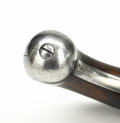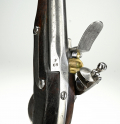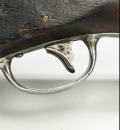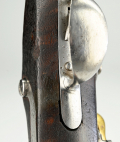site search
online catalog
RARE WAR OF 1812 SIMEON NORTH U.S. MODEL 1813 ARMY PISTOL
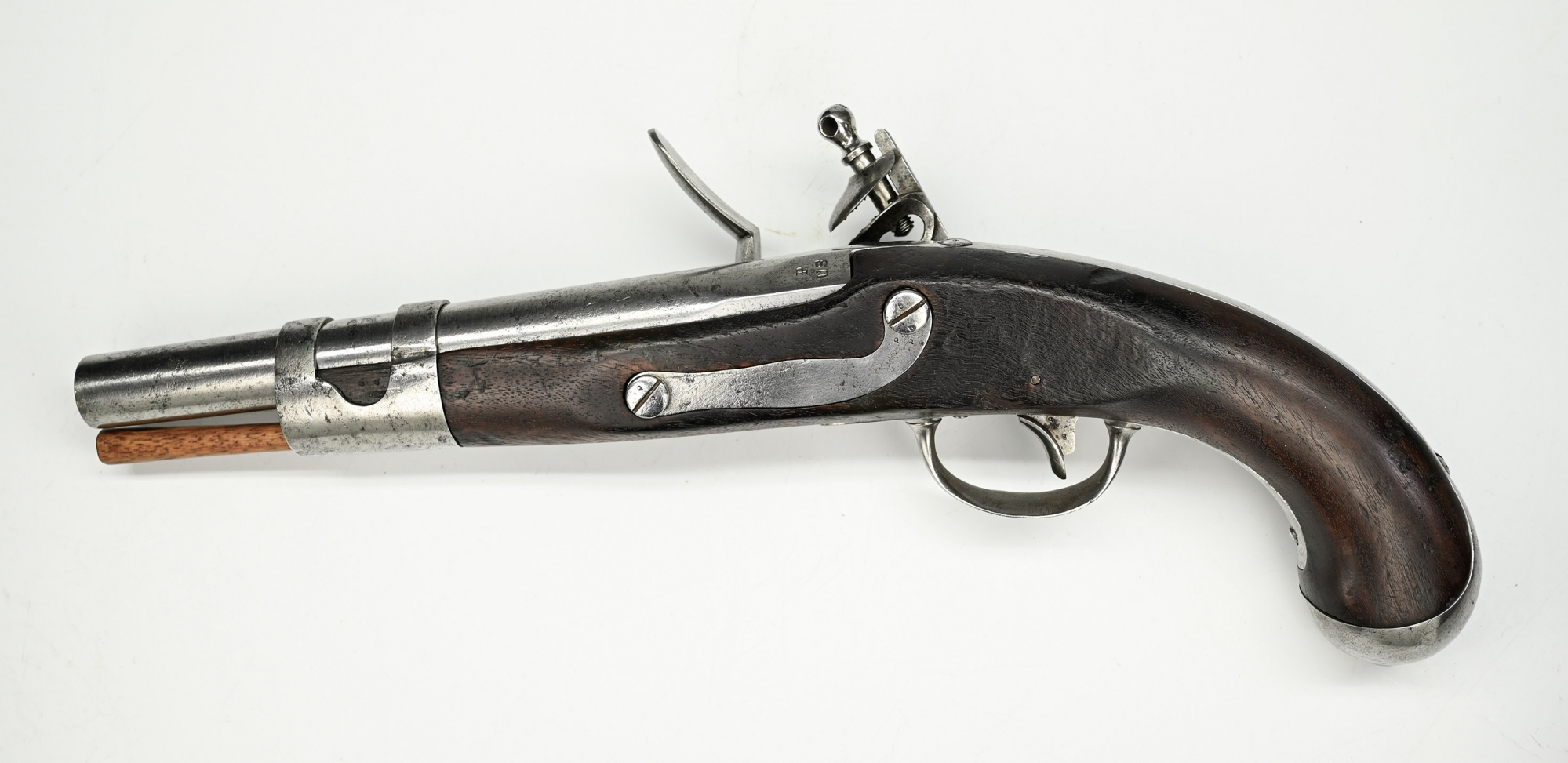
$2,700.00
Quantity Available: 1
Item Code: 431-69
Shipping: Determined by Method & Location of buyer
To Order:
Call 717-334-0347,
Fax 717-334-5016, or E-mail
This is a very professional and very well done reconversion to flint of a very hard to find US military pistol, in strong condition, showing very good metal, sharp lock, proof and mating markings, and wood with generally good surface showing the remnants of a cartouche. Smith and Bittner call this, “one of the rarest U.S. martial pistols.” It is generally accepted that just 626 were manufactured and delivered to the army by Simeon North between the signing of the contract in April 1813 and cessation of manufacture in 1815, and possibly as few as 541 of this configuration.
The pistol features a .69 caliber 9” inch barrel- barrel lengths might vary slightly, this is on the nose- in .69 caliber and follows the lines of North’s improved Model 1811 pistols using the double-strapped Wickham nose band with the stock ending flush with it, but uses a simple, inclined separate brass pan without fence, eliminates the bent tip of the frizzen, and uses a lock plate beveled at the front and slightly rounded at the rear. These were produced by North at his new factory in Middletown, CT, and the lock plates are marked forward of the hammer, S. NORTH / U [EAGLE] S / MIDLN CON. with the upper and lower lines in arcs surrounding the middle US/[eagle] motif. The left barrel flat has stamped P/US proofs.
With the restoration to flint, the metal was carefully returned to a natural bright, shows a generally smooth surface with only some remnants of shallow pitting (“freckling” as some prefer) with some thin gray spots on the straps of the muzzle band and on the muzzle, just couple of light nicks aft of the that, and strong, sharp “P/US” barrel proofs on the left breech. As is correct, there are no sights. The grip backstrap, triggerguard with grip strap, and butt cap are smooth metal and in very good condition. The lockplate is excellent, with smooth surface showing just some thin grays and sharp, correct, lock markings showing just a tad of rubbing to the eagle’s chest. The hammer, frizzen, frizzen spring, etc., all match the lock plate for condition and color, the sharpness of the screw slots or machining in the pan perhaps being the only give away. The vent hole is sharp, with no signs of welding, indicating it was likely a side-lug conversion, but not used much since there is no evident corrosion from percussion caps. The sideplate matches the condition of the rest of the metal and shows small “Q” mating stamps as do the other lock screw heads, the butt cap, butt cap screws, back strap screw, triggerguard plate and even the trigger.
The wood has good color, grain and finish, though with some dings, etc., that we note, but are not very obtrusive: the lock apron shows a little rounding at the front, sharper edges at the back and along the bottom, with a very slight gap along the rear top to the point of the plate with a short hairline and a small nick on the lower edge toward the rear. On the upper right grip there is a small chip, smoothed by age, above the rear of the triggerguard bow. On the left there is a slight scrape aft of the muzzle band; the fit of the sideplate is very good; the counterpane shows slight rounding to the edges with a small chip on the bottom edge just forward of the trigger pin; there is a shallow pressure dent on the top left wrist, about two thirds of the way along the counterpane. The handle shows only minor handling marks. The fit of grip straps and butt cap is very good. On the underside there is a slight gap around the tip and forward left edge of the triggerguard tang and the narrow chip to the lower edge of the counterpane, mentioned already. See our photos: none of these things detracts much from this rare pistol. In terms of the wood, we note especially the clear oval outline of an inspector’s mark on the counterpane just aft of the rear lock screw. This would be the “LS” mark of Luther Sage. The only other inspector known, Henry Peterkin, would also have had his initials on the counterpane, but additionally marked his barrels with an “H.H.P.” on the barrel breech, whereas Sage marked only the counterpane. A wood ramrod, lighter in color, is in place, though certainly a replacement.
As mentioned above, these pistols had a very limited production run. It turned out that .69 caliber, though fine for a musket, was a bit much for a pistol and the contract, which had called for 20,000 pistols, was suspended in 1815 after just 626 had been supplied. Of these, perhaps 85 had been fabricated using older, shorter, Model 1811 pistol barrels and flat lock plates, leaving about 541 of this configuration. The contract was renegotiated in January 1816 for the difference of 19,374 pistols, but in .54 caliber, a pattern that became North’s Model 1816. This left North with a large number of .69 caliber pistol barrels and other parts on hand, but he managed to put them to use in fulfilling a navy contract for 1,000 pistols, signed in September 1816 and completed in November. Those navy versions are distinguishable from this even scarcer army version by their “E.T.” inspector cartouches, naval belt hooks or, if the hook is missing, longer rear lock screws used to anchor the belt hooks, or a plugged hole in the side flat to the rear of that screw that had once secured the belt hook stud.
In addition to their historical interest as a War of 1812 cavalry arm, and their rarity, these pistols are also part of the progression of U.S. industry toward mass, assembly-line, production and manufacturing tolerances close enough to make parts interchangeable. In fact, this latter point is said to have been included in North’s contract, though North apparently only referred to making the locks so uniform that they might be switched, noted in a letter mentioned by Smith and Bittner. North did organize his production using specialized labor, which would produce greater uniformity and perhaps parts that were “identical,” but interchangeable was another question and a goal yet to be achieved: we note the mating symbols on the various parts of the pistol.
This is a very hard to find pistol that would likely fill a void in a US martial pistol collection, cavalry, or War of 1812 display. [sr] [ph:m]
DISCLAIMER: All firearms are sold as collector's items only - we do not accept responsibility as to the shooting safety or reliability of any antique firearm. All firearms are described as accurately as possible, given the restraints of a catalog listing length. We want satisfied customers & often "under" describe the weapons. Any city or state regulations regarding owning antique firearms are the responsibility of the purchaser. All firearms are "mechanically perfect" unless noted, but again, are NOT warranted as safe to fire!
~~~~~~~~~~~~~~~~~~~~~~~~~~~~~~~~~~~
THIS ITEM, AS WITH ALL OTHER ITEMS AVAILABLE ON OUR WEB SITE,
MAY BE PURCHASED THROUGH OUR LAYAWAY PROGRAM.
CLICK HERE FOR OUR POLICIES AND TERMS.
THANK YOU!
Inquire About RARE WAR OF 1812 SIMEON NORTH U.S. MODEL 1813 ARMY PISTOL
For inquiries, please email us at [email protected]
Most Popular
Historical Firearms Stolen From The National Civil War Museum In Harrisburg, Pa »
Theft From Gravesite Of Gen. John Reynolds »
Selection Of Unframed Prints By Don Troiani »
Fine Condition Brass Infantry Bugle Insignia »
British Imported, Confederate Used Bayonet »
Scarce New Model 1865 Sharps Still In Percussion Near Factory New »
featured item
VERY RARE US MODEL 1840 AMES CAVALRY OFFICER’S SWORD WITH QUILLBACK SOLINGEN BLADE
Very rare Ames with gold washed, quillback, Damascus blade from Solingen. Manufactured: Springfield, MA / Solingen Maker: N.P.Ames Year: C1840s Model: M1840 Size: 33 5/8 inch blade length, 1.18 wide Condition: Excellent+ This is obviously a product… (870-238). Learn More »
site search
Upcoming Events
May 16 - 18: N-SSA Spring Nationals, Fort Shenandoah, Winchester, VA Learn More »






